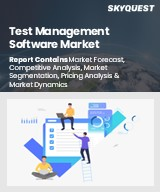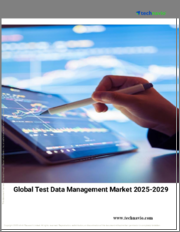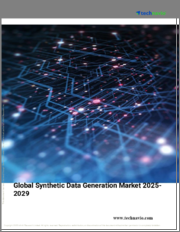
|
시장보고서
상품코드
1663857
합성 데이터 생성 시장 규모, 점유율, 성장 분석 : 데이터 유형별, 모델링 유형별, 제공별, 용도별, 최종 용도별, 지역별 - 산업 예측(2025-2032년)Synthetic Data Generation Market Size, Share, and Growth Analysis, By Data Type (Tabular Data, Text Data), By Modeling Type (Direct Modeling, Agent-Based Modeling), By Offering, By Application, By End Use, By Region - Industry Forecast 2025-2032 |
||||||
합성 데이터 생성 시장 규모는 2023년 3억 6,176만 달러로 평가되며, 예측 기간(2025-2032년) 동안 37.4%의 CAGR로 2024년 4억 9,706만 달러에서 2032년 63억 1,395만 달러로 성장할 것으로 예상됩니다.
세계 합성 데이터 생성 시장은 자율주행차, 헬스케어, 금융을 중심으로 한 다양한 산업 애플리케이션으로 인해 크게 성장하고 있습니다. 보안과 컴플라이언스에 대한 관심이 높아지면서 조직은 기밀 정보를 훼손하지 않고도 필수적인 데이터세트를 생성할 수 있는 합성 데이터를 활용하고 있습니다. 첨단 AI 기술을 통해 실제 행동을 정확하게 모방한 복잡한 합성 데이터세트를 생성할 수 있습니다. 고품질의 준비된 데이터에 중점을 두면 합성 데이터의 유용성을 높이고, 견고한 AI 모델 개발을 강화할 수 있습니다. 조직이 AI 기반 합성 데이터의 이점을 인식함에 따라 클라우드 플랫폼과의 통합은 유연성과 원활한 워크플로우 통합을 제공합니다. 이러한 추세는 업계 전반의 클라우드 솔루션으로의 전환과 맞물려 다양한 분야에서 합성 데이터 활용에 있어 협업과 상호운용성을 촉진할 것입니다.
목차
소개
- 조사 목적
- 조사 범위
- 정의
조사 방법
- 정보 조달
- 2차와 1차 데이터 방법
- 시장 규모 예측
- 시장 가정과 제한
주요 요약
- 세계 시장 전망
- 공급과 수요 동향 분석
- 부문별 기회 분석
시장 역학과 전망
- 시장 개요
- 시장 규모
- 시장 역학
- 성장 촉진요인과 기회
- 성장 억제요인과 과제
- Porters 분석
주요 시장 인사이트
- 핵심성공요인
- 경쟁 정도
- 주요 투자 기회
- 시장 생태계
- 시장 매력 지수(2024년)
- PESTEL 분석
- 거시경제 지표
- 밸류체인 분석
- 가격 분석
- 사례 연구
- 특허 분석
- 기술 분석
합성 데이터 생성 시장 규모 : 데이터 유형별
- 시장 개요
- 표형식 데이터
- 텍스트 데이터
- 이미지 및 비디오 데이터
- 기타
합성 데이터 생성 시장 규모 : 모델링 유형별
- 시장 개요
- 다이렉트 모델링
- 에이전트 기반 모델링
합성 데이터 생성 시장 규모 : 제공별
- 시장 개요
- 소프트웨어
- 서비스
합성 데이터 생성 시장 규모 : 용도별
- 시장 개요
- AI 트레이닝
- 예측 분석
- 데이터 프라이버시
- 부정행위 검출
- 자율주행차
- 헬스케어
합성 데이터 생성 시장 규모 : 최종 용도별
- 시장 개요
- BFSI(은행, 금융 서비스, 보험)
- 헬스케어
- 자동차
- 소매
- IT 및 통신
- 정부
합성 데이터 생성 시장 규모
- 북미
- 미국
- 캐나다
- 유럽
- 독일
- 스페인
- 프랑스
- 영국
- 이탈리아
- 기타 유럽
- 아시아태평양
- 중국
- 인도
- 일본
- 한국
- 기타 아시아태평양
- 라틴아메리카
- 브라질
- 기타 라틴아메리카
- 중동 및 아프리카
- GCC 국가
- 남아프리카공화국
- 기타 중동 및 아프리카
경쟁 정보
- 상위 5개사의 비교
- 주요 기업의 시장 포지셔닝(2024년)
- 주요 시장 기업이 채용한 전략
- 최근의 시장 동향
- 기업의 시장 점유율 분석(2024년)
- 주요 기업 개요
- 기업 상세
- 제품 포트폴리오 분석
- 기업 부문별 점유율 분석
- 매출 전년비 비교(2022-2024년)
주요 기업 개요
- NVIDIA Corporation(USA)
- IBM Corporation(USA)
- Microsoft Corporation(USA)
- Google LLC(USA)
- Amazon Web Services(AWS)(USA)
- Synthetic Data, Inc.(USA)
- Hazy(UK)
- Synthesis AI(USA)
- TruEra(USA)
- Gretel.ai(USA)
- Zeta Alpha(Netherlands)
- DataGen(Israel)
- Mostly AI(Austria)
- Tonic.ai(USA)
- Aurora(USA)
- Mindtech Global(UK)
- Parallel Domain(USA)
- AI.Reverie(USA)
- Anyverse(Spain)
- Cognata(Israel)
결론과 제안
ksm 25.03.26Synthetic Data Generation Market size was valued at USD 361.76 million in 2023 and is poised to grow from USD 497.06 million in 2024 to USD 6313.95 million by 2032, growing at a CAGR of 37.4% during the forecast period (2025-2032).
The global synthetic data generation market is experiencing significant growth, spurred by diverse industry applications, particularly in autonomous vehicles, healthcare, and finance. Rising concerns over security and compliance are driving organizations to leverage synthetic data, enabling the creation of essential datasets without compromising sensitive information. Advanced AI techniques allow for the generation of complex synthetic datasets that accurately mimic real-world behaviors. The emphasis on high-quality preparatory data enhances synthetic data's utility and fortifies the development of robust AI models. As organizations increasingly recognize the benefits of AI-driven synthetic data, the integration with cloud platforms offers flexibility and seamless workflow incorporation. This trend aligns with a broader industry shift toward cloud solutions, facilitating collaboration and interoperability in synthetic data usage across various sectors.
Top-down and bottom-up approaches were used to estimate and validate the size of the Synthetic Data Generation market and to estimate the size of various other dependent submarkets. The research methodology used to estimate the market size includes the following details: The key players in the market were identified through secondary research, and their market shares in the respective regions were determined through primary and secondary research. This entire procedure includes the study of the annual and financial reports of the top market players and extensive interviews for key insights from industry leaders such as CEOs, VPs, directors, and marketing executives. All percentage shares split, and breakdowns were determined using secondary sources and verified through Primary sources. All possible parameters that affect the markets covered in this research study have been accounted for, viewed in extensive detail, verified through primary research, and analyzed to get the final quantitative and qualitative data.
Synthetic Data Generation Market Segments Analysis
Global Synthetic Data Generation Market is segmented by Data Type, Modeling Type, Offering, Application, End Use and region. Based on Data Type, the market is segmented into Tabular Data, Text Data, Image & Video Data and Others. Based on Modeling Type, the market is segmented into Direct Modeling and Agent-Based Modeling. Based on Offering, the market is segmented into Software and Services. Based on Application, the market is segmented into AI Training, Predictive Analytics, Data Privacy, Fraud Detection, Autonomous Vehicles and Healthcare. Based on End Use, the market is segmented into BFSI (Banking, Financial Services, and Insurance), Healthcare, Automotive, Retail, IT & Telecom and Government. Based on region, the market is segmented into North America, Europe, Asia Pacific, Latin America and Middle East & Africa.
Driver of the Synthetic Data Generation Market
A key catalyst for the growth of the global synthetic data generation market is the escalating concern surrounding data privacy and protection. As regulations like the General Data Protection Regulation (GDPR) become more prevalent, organizations are increasingly turning to synthetic data to train their AI models. This approach allows them to safeguard individual and sensitive information while adhering to regulatory requirements. Moreover, it addresses privacy challenges by generating high-quality data that mimics real datasets, thus enabling companies to innovate and develop their technologies without the risk of violating data protection laws. Consequently, the demand for synthetic data solutions continues to rise.
Restraints in the Synthetic Data Generation Market
A key challenge in the Synthetic Data Generation market is maintaining the accuracy and quality of the produced data. Although it's feasible to generate synthetic datasets that mimic the original, discrepancies in data representation or inherent biases can adversely impact model training. Consequently, these synthetic datasets must undergo rigorous validation and testing processes to ensure their reliability, adding complexity to the generation process. This heightened scrutiny may lead to trust issues within the market, potentially acting as a barrier to broader adoption. Therefore, the need for comprehensive validation mechanisms is critical for fostering confidence in synthetic data technologies.
Market Trends of the Synthetic Data Generation Market
The Synthetic Data Generation market is witnessing a significant trend towards the increased adoption of AI-driven solutions, as organizations across various sectors, including healthcare, finance, and automotive, seek cost-effective and scalable ways to generate diverse datasets. By leveraging machine learning algorithms, companies can enhance the accuracy of their predictive models while minimizing the burden of traditional data generation methods. Additionally, synthetic data alleviates privacy concerns associated with utilizing real-world data, making it an attractive option for firms looking to innovate responsibly. This trend signifies a transformative shift in data management strategies, positioning synthetic data as an essential component of modern data-driven enterprises.
Table of Contents
Introduction
- Objectives of the Study
- Scope of the Report
- Definitions
Research Methodology
- Information Procurement
- Secondary & Primary Data Methods
- Market Size Estimation
- Market Assumptions & Limitations
Executive Summary
- Global Market Outlook
- Supply & Demand Trend Analysis
- Segmental Opportunity Analysis
Market Dynamics & Outlook
- Market Overview
- Market Size
- Market Dynamics
- Drivers & Opportunities
- Restraints & Challenges
- Porters Analysis
- Competitive rivalry
- Threat of substitute
- Bargaining power of buyers
- Threat of new entrants
- Bargaining power of suppliers
Key Market Insights
- Key Success Factors
- Degree of Competition
- Top Investment Pockets
- Market Ecosystem
- Market Attractiveness Index, 2024
- PESTEL Analysis
- Macro-Economic Indicators
- Value Chain Analysis
- Pricing Analysis
- Case Studies
- Patent Analysis
- Technology Analysis
Global Synthetic Data Generation Market Size by Data Type & CAGR (2025-2032)
- Market Overview
- Tabular Data
- Text Data
- Image & Video Data
- Others
Global Synthetic Data Generation Market Size by Modeling Type & CAGR (2025-2032)
- Market Overview
- Direct Modeling
- Agent-Based Modeling
Global Synthetic Data Generation Market Size by Offering & CAGR (2025-2032)
- Market Overview
- Software
- Services
Global Synthetic Data Generation Market Size by Application & CAGR (2025-2032)
- Market Overview
- AI Training
- Predictive Analytics
- Data Privacy
- Fraud Detection
- Autonomous Vehicles
- Healthcare
Global Synthetic Data Generation Market Size by End Use & CAGR (2025-2032)
- Market Overview
- BFSI (Banking, Financial Services, and Insurance)
- Healthcare
- Automotive
- Retail
- IT & Telecom
- Government
Global Synthetic Data Generation Market Size & CAGR (2025-2032)
- North America (Data Type, Modeling Type, Offering, Application, End Use)
- US
- Canada
- Europe (Data Type, Modeling Type, Offering, Application, End Use)
- Germany
- Spain
- France
- UK
- Italy
- Rest of Europe
- Asia Pacific (Data Type, Modeling Type, Offering, Application, End Use)
- China
- India
- Japan
- South Korea
- Rest of Asia-Pacific
- Latin America (Data Type, Modeling Type, Offering, Application, End Use)
- Brazil
- Rest of Latin America
- Middle East & Africa (Data Type, Modeling Type, Offering, Application, End Use)
- GCC Countries
- South Africa
- Rest of Middle East & Africa
Competitive Intelligence
- Top 5 Player Comparison
- Market Positioning of Key Players, 2024
- Strategies Adopted by Key Market Players
- Recent Developments in the Market
- Company Market Share Analysis, 2024
- Company Profiles of All Key Players
- Company Details
- Product Portfolio Analysis
- Company's Segmental Share Analysis
- Revenue Y-O-Y Comparison (2022-2024)
Key Company Profiles
- NVIDIA Corporation (USA)
- Company Overview
- Business Segment Overview
- Financial Updates
- Key Developments
- IBM Corporation (USA)
- Company Overview
- Business Segment Overview
- Financial Updates
- Key Developments
- Microsoft Corporation (USA)
- Company Overview
- Business Segment Overview
- Financial Updates
- Key Developments
- Google LLC (USA)
- Company Overview
- Business Segment Overview
- Financial Updates
- Key Developments
- Amazon Web Services (AWS) (USA)
- Company Overview
- Business Segment Overview
- Financial Updates
- Key Developments
- Synthetic Data, Inc. (USA)
- Company Overview
- Business Segment Overview
- Financial Updates
- Key Developments
- Hazy (UK)
- Company Overview
- Business Segment Overview
- Financial Updates
- Key Developments
- Synthesis AI (USA)
- Company Overview
- Business Segment Overview
- Financial Updates
- Key Developments
- TruEra (USA)
- Company Overview
- Business Segment Overview
- Financial Updates
- Key Developments
- Gretel.ai (USA)
- Company Overview
- Business Segment Overview
- Financial Updates
- Key Developments
- Zeta Alpha (Netherlands)
- Company Overview
- Business Segment Overview
- Financial Updates
- Key Developments
- DataGen (Israel)
- Company Overview
- Business Segment Overview
- Financial Updates
- Key Developments
- Mostly AI (Austria)
- Company Overview
- Business Segment Overview
- Financial Updates
- Key Developments
- Tonic.ai (USA)
- Company Overview
- Business Segment Overview
- Financial Updates
- Key Developments
- Aurora (USA)
- Company Overview
- Business Segment Overview
- Financial Updates
- Key Developments
- Mindtech Global (UK)
- Company Overview
- Business Segment Overview
- Financial Updates
- Key Developments
- Parallel Domain (USA)
- Company Overview
- Business Segment Overview
- Financial Updates
- Key Developments
- AI.Reverie (USA)
- Company Overview
- Business Segment Overview
- Financial Updates
- Key Developments
- Anyverse (Spain)
- Company Overview
- Business Segment Overview
- Financial Updates
- Key Developments
- Cognata (Israel)
- Company Overview
- Business Segment Overview
- Financial Updates
- Key Developments



















